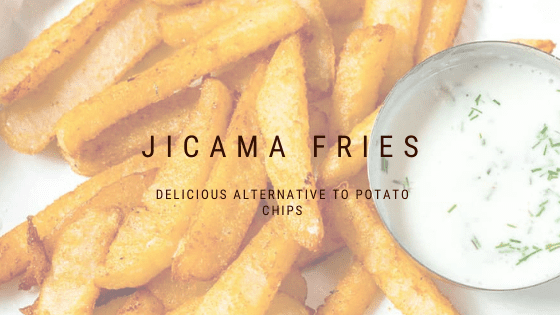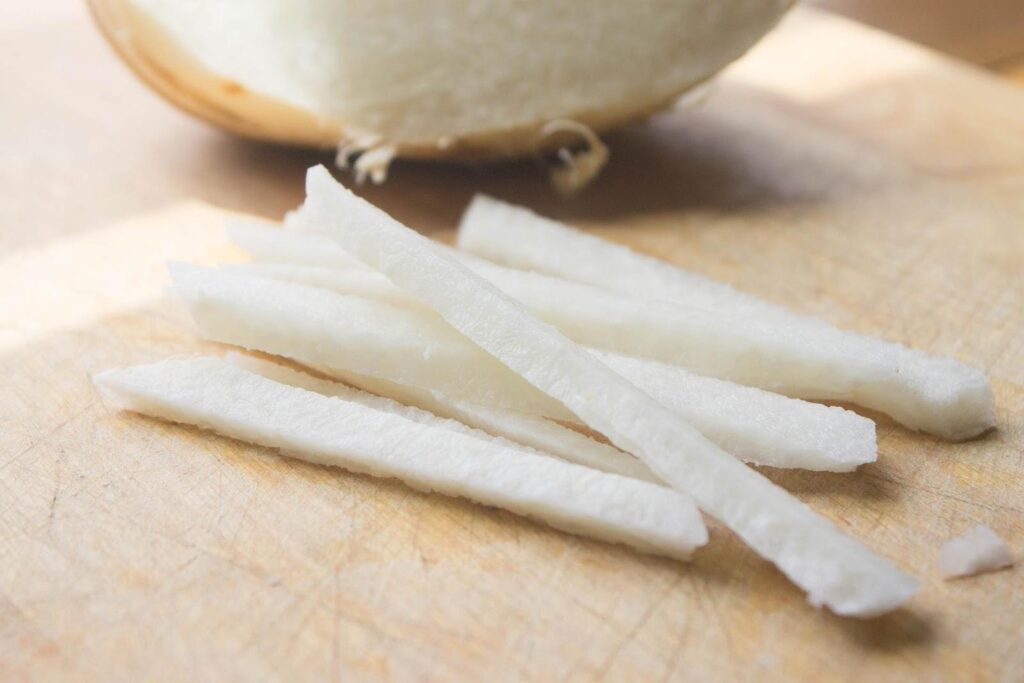
Table of Contents
What do you think of when you hear the word “jicama?” Well, you are probably salivating at the thought. Jicama is a root vegetable with an interesting texture and flavor and what makes it more loved is that it can also be eaten raw!
In this blog post, we will show how to make jicama fries in three easy steps. These fries are great as a side dish with burgers and sandwiches, but they can also be used as appetizers if cut up small enough!
DISCLAIMER: The Content is not intended to be a substitute for professional medical advice, diagnosis, or treatment. Always seek the advice of your physician or other qualified health providers with any questions you may have regarding a medical condition.
What is Jicama?

Jicama (pronounced HEE – Kuh -Muh) is in the ground apple family whose name means “upside-down apple.” It is used as a vegetable and has an edible brown, paper-like skin and white, crisp interior.
Jicama’s high water content makes it an excellent food to eat when dieting since it is low in calories but a good source of fiber from its plantain family roots. Jicamas also provide vitamin C, magnesium, copper, and manganese – minerals that contribute to physical wellness.
How to Make Jicama Fries
Now that your taste buds are all tingling with anticipation. Here are the three simple steps needed to make a jicama recipe.
Step One:
First, you’ll need to peel the jicama and cut it into large french fry pieces. Preheat your oven or air-fryer to 425 degrees Fahrenheit (220 degrees Celsius).
After cutting up the jicamas, place them on a baking sheet lined with parchment paper. With a brush or a spoon, coat the jicamas with oil and season them as desired.
Step Two:
Bake for 15 minutes on each side (30 total), flipping halfway through to cook evenly. If using an air-fryer, cook it at 360 degrees Fahrenheit (180 degrees Celsius) for 20 minutes per batch.
Step Three:
When the jicama has cooled enough to handle it without burning your hands (approximately 15 minutes), take a paper towel and gently blot away any excess oil from them. Add more seasoning as desired and enjoy with ranch or other dipping sauces of choice!
How To Make Jicama In An Air Fryer
Many health-conscious people have turned to use air fryers instead of baking their food in ovens or deep frying. This is because air fryers use very little oil. The fries also come out crunchy on the outside and soft inside. So how can you make your jicama the healthy way in an air fryer?
Step 1. Peel and slice your jicama
Step 2. Place the sliced pieces of crispy baked potatoes into an air fryer basket.
Step 3. Place the fries into the air frying appliance and set it on 400 degrees for 20 minutes.
How To Prepare Jicama As a Salad
- Peel the jicama and cut it into cubes.
- Add lime juice, salt, pepper, or other spices you like to taste.
- Mix with your favorite salad ingredients: cabbage mix, tomatoes, cucumbers, and parsley leaves, for example.
How To Prepare Raw Jicama

Jicama can be eaten raw or fried, and you can eat this vegetable as a snack while watching TV. This will help fill your stomach to prevent overeating later on in the day when hunger hits hard again.
To prepare this vegetable, wash the jicama under water and peel it with a knife or potato peeler. If you want to eat as is without peeling your Jicama first, then scrub off any dirt from the skin by rubbing your fingers against its surface in circular motions until there is no dirt left.
Next, slice the jicama into quarters and then peel off any skins still attached to it with your fingers or a paring knife. If you want to eat raw in chunks, cut them about one inch thick at an angle, so each piece of the veggie is different from all others, like hamburger patties.
Then, cut the jicama into one to two-inch pieces or strips and enjoy it as a snack while you watch tv. Some people believe that eating raw vegetables is better for weight loss because they fill your stomach up faster than if you were to eat cooked food items. You can also enjoy your raw Jicama by dipping it into honey.
Dipping Sauces That Go Well With Fried Jicamas
Mayonnaise is a very versatile sauce that you can use as a dipping sauce for almost your crispy and satisfying Jicamas.
You can also mix equal parts mayonnaise and ketchup in a small bowl and use it as a dipping for your Jicamas.
How to use Jicama
So you may be wondering what it tastes like when eaten raw. Well, jicama tastes the same as an uncooked potato, but you will find it much juicier and sweeter. If you want to add flavor and texture to various dishes, then use jicama.
- Simply slice it thinly and add to your vegetable salad. This will give it some crunch.
- You can also add some sea salt and lime, then serve on top of an avocado puree.
- You can also sauté and toss it together with other vegetables like carrots and broccoli.
Other uses of Jicamas
A Jicama is also used as a natural way to soothe upset stomachs because the fruit contains fiber, vitamin C, copper, potassium, magnesium, and manganese.
Jicama can also be juiced for its high levels of calcium which are more bioavailable in this form than from milk or supplementary products.
Jicama’s Nutritional Value
Jicama, a Mexican root vegetable also known as the “Mexican Turnip,” is an excellent and healthy alternative to higher-calorie foods.
Dietary Information
Only 49 calories but packs in 12 grams of carbs which make it great for those who are cutting back on their carb intake while still feeling satisfied. Jicamas contain 6% or more than your daily value in vitamin C, folate, iron magnesium, and potassium, making them perfect if you’re looking for veggies that fill up fast with few calories!
The table below summarizes the dietary information of jicama.
One cup (130 grams) of jicama contains:
Nutrient | Value |
calories | 49 |
carbohydrates | 12 grams |
protein | 1 gram |
fat | 0.1 grams |
fiber | 6.4 grams |
Vitamin C | 44% of Recommended dietary intake |
Folate | 4% of Recommended dietary intake |
iron | 4% of Recommended dietary intake |
magnesium | 4% of Recommended dietary intake |
Potassium | 6% of Recommended dietary intake |
Manganese | 4% of Recommended dietary intake |
9 Benefits of Eating Jicama
Whether you’re trying to lose weight or just want to eat healthier, here are some benefits of eating jicama.
It’s low in calories
One cup of raw jicama is only 50 calories, making it an excellent food for people looking to trim down or maintain their weight. By comparison, a medium-sized banana has 110 calories and one slice of bread can have anywhere from 80-150 depending on the type.
Helps with digestion.
Jicama is high in natural fiber, which aids digestion. Jicama also contains a type of prebiotic called fructooligosaccharide (FOS) that promotes healthy gut bacteria and digestive health. Some studies show that FOS can help lower cholesterol levels; this may be due to the body’s release of bile acids and cholesterol into the digestive tract.
Jicama also contains high water content, which will be perfect for easing constipation. High water content in jicama will help you meet your daily water needs.
It’s a great source of Vitamin B-complex.
Jicamas are rich in vitamin B-complex, which means that they will help boost your mood by reducing anxiety and depression while stabilizing your blood sugar levels. They also contain a significant amount of potassium which helps balance the salt content of sodium content, so it’s not as harsh.
High in fiber
Jicama is also high in fiber, which helps you feel fuller and will make it easier to avoid unhealthy snacking throughout the day. It also helps reduce your risk of colon cancer. The fiber found in Jicama also regulates the digestion and elimination systems, reducing constipation and hemorrhoids.
Hormonal imbalance
The natural sugars found within jicama are good for reducing hormone imbalances and keeping cravings at bay. The compounds found in the Jicana help regulate hormones such as estrogen and progesterone.
Helps regulate blood pressure
Jicama is a great source of minerals, such as potassium and magnesium. These help with blood pressure regulation and muscle recovery after exercise.
Prevents colds and flu
Jicama contains Vitamin C, which can help prevent colds or flu symptoms from developing.
Cravings
It is also low in calories (approximately 50 per pound), so you can have a satisfying snack without overdoing it. Jicama is a great substitute for high-carbohydrate snacks like french fries or chips.
Source of vitamin A
Jicama is also a good source of vitamin A, which helps promote eye health and skin beauty.
Where To Find Jicama
Jicama is a vegetable that can be found in the produce section of most grocery stores, but just in case you do not know what it looks like: It looks like beetroot but is dark brown on the outside. The Inside is light-colored with rings near the skin to facilitate easy peeling. The flesh inside the jicama resembles an apple.
How to Store Jicama
When you go shopping, choose jicama that is firm because those with soft spots are overripe and often moldy. When it comes to storing, store in a cool and dry place. Your jicama will be good for 2 to 3 weeks. But if you cut it and need to store it, make sure you wrap it very tightly and store it in your refrigerator for a week.
Peeling and Cutting Jicama
When peeling your jicama, it is advised to use a sharp knife as opposed to using a peeler. This is because the vegetable peeler can not cut through the skin of the jicama. The steps highlighted below will help you during the preparation phase.
- Step One: place your jicama on a cutting board and slice two thin horizontal slices off the top and bottom of the jicama. This will help you get a better grip on it while peeling or cutting.
- Step Two: Peel away any brown skin using a vegetable peeler, then cut into matchsticks for salads, wedges for roasting with other vegetables, or cubes for adding to soups and stews.
- Step Three: To cube the jicama, cut off both ends of the vegetable with a sharp knife and then slice lengthwise into quarters (cut from top to bottom). Lay each quarter on its side and make thin cuts perpendicular to your first set of cuts.
- Step Four: To cut the jicama into matchsticks, start at one end and make thin cuts lengthwise along with the vegetable until you reach the other end. You may need to rotate your jicama after each set of cuts so that it doesn’t roll around on you.
Frequently Asked Questions About Jicamas (FAQs)
What is Jicama?
Jicama, a Mexican root vegetable with brown skin and white flesh that resembles ginger in taste. The soft texture of jicamas makes them an excellent choice for salads.
Is Jicama keto approved?
Yes, Jicama is not only keto-approved but also low carb friendly. There are many nutritional advantages to adding jicamas to your keto diet. First, they have no cholesterol or fat and very low sugar content. They’re also rich in potassium and dietary fiber that help lower blood pressure by regulating fluid levels and reducing constipation.
Does Jicama cause gas?
Jicama is not known to cause gas. However, it can take a while for the body to adjust. If you experience excess gas after eating jicama, this could be due to other factors such as your gut microbiome or lack of probiotics in your diet.
If I have diabetes should I eat Jicama?
Yes, you can eat, but In moderation. High blood sugar levels are not a concern for those who eat one or two servings of jicama per day in addition to the usual meal plan and physical activity program. If you have diabetes, it is best to consult your physician before adding any new foods into your diet.
Conclusion
Jicamas are a great way to add more fiber and nutrients to your diet while still staying on track with your weight loss goals. Since jicamas provide vitamin C, magnesium, copper, and manganese – minerals that contribute to physical wellness, they’re an ideal food for anyone looking for the benefits of eating healthy without feeling deprived or hungry. If you haven’t tried this refreshing root vegetable yet, we recommend giving it a try! So next time you see this healthy veggie at the grocery store or farmers market, don’t pass it up!
Did you like this article? Check our similar posts:
Banana Milk: What It Is, Health Benefits, Downsides, How To Make It & FAQs
